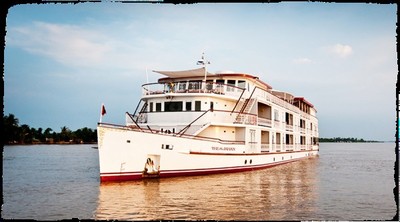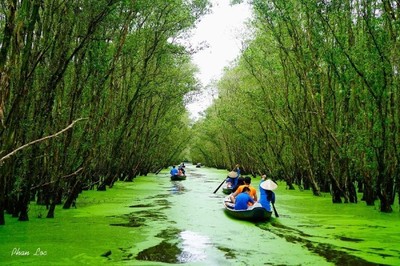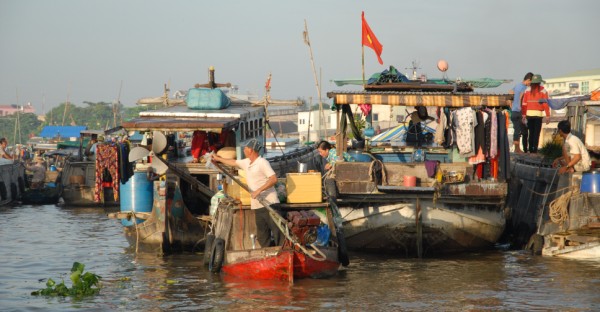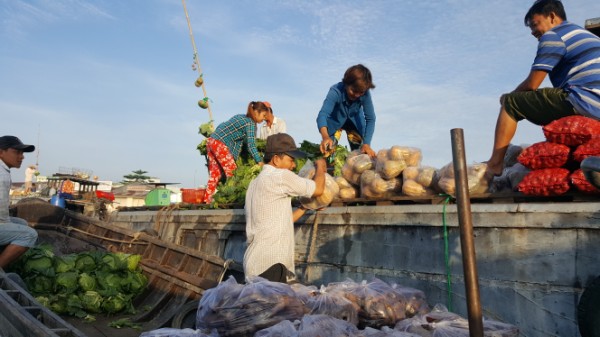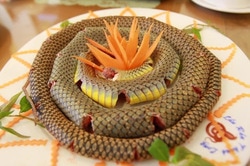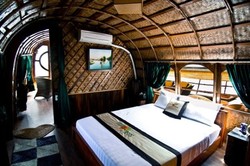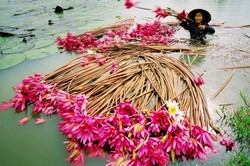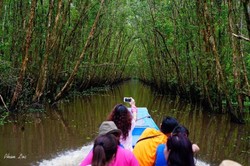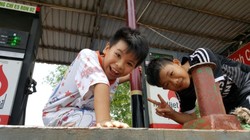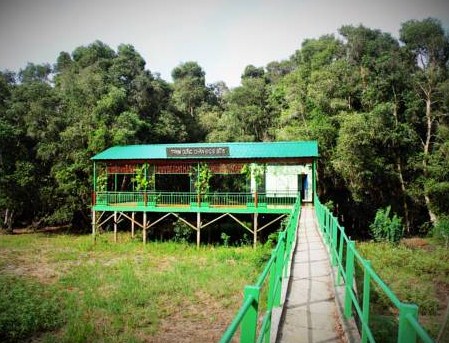On my first trip to Vietnam, I visited some of the requisite beautiful places in the north (Halong Bay, Sapa), but I also knew I wanted to get deeper into Vietnam and experience more traditional life. I set my sights on the Mekong Delta—it sounded a bit mysterious from my western perspective, but I didn’t know if it would be a “land that time forgot”, or if progress had caught up and it would be a big city.
|
The attraction for me was to experience the floating produce and vegetable markets. Where growers bring their goods down river (or up river) by boat to meet buyers from local villages, and conduct their transactions from boat to boat. The majority of buyers then re-sell the fruits and vegetables in the local villages to stores or direct to residents.
I also wanted to see more of "traditional" Vietnam, how families have lived for generations, without much western influence. It's a culture that may not be around much longer in its pure form as globalization progresses. |
There are several towns along the delta that have held these daily floating markets for hundreds of years - Cai Be and Tra On floating markets in Vinh Long, Cai Rang and Phong Dien floating markets in Can Tho, Phung Hiep floating market in Nga Bay town, Hau Giang, Long Xuyen floating markets in An Giang, Nga Nam floating market in Soc Trang and many more in this world of river canals. Other towns are home to rice growers and local southern Vietnamese residents, living in beautiful local tradition, like My Tho, Ben Tre, Sa Dec, Can Tho, Bac Lieu, Ca Mau, Long Xuyen, and Chau Doc.
I chose Can Tho because it was farther away from Ho Chi Minh City, assumingly less-touristed, and it houses one of the larger floating markets, Cai Rang.
I chose Can Tho because it was farther away from Ho Chi Minh City, assumingly less-touristed, and it houses one of the larger floating markets, Cai Rang.
-- Richard
Classic sightseeingTaking a very early morning boat ride, from a local woman in her single engine/propeller wooden boat, down the Mekong river or one of its tributaries, is the best experience. Visit a floating market or two, then take some extra time to wander up one of the smaller canals to get up close to local daily life. You can visit rice noodle factories, rice paddy farming, fruit orchards, ship building, rice husking mill, coconut processing workshop, and take a walk, ride a tuk tuk or ride a bicycle through the outlying villages and see how the Southern Vietnamese people live.
Activities here mostly bring you closer to local daily life. You can row a sampan on canals lined on both sides by lush water coconut trees, ride a motorbike, ox cart or tuk tuk on the villages’ narrow and peaceful paths, or try fishing with a net or bamboo traps. You can also stay overnight with a local family if you like and learn how to cook local food in Southern Vietnamese style. Your best memories in the delta will be by the water. Strolling the waterfront, having a meal overlooking the riverbank, and of course your boat trips on the water. |
From Can Tho, you can travel farther to Rach Gia to take a speedboat south to Phu Quoc Island or to Chau Doc, a border town with Cambodia and take a 6 hour speedboat to Phnom Penh, Cambodia.
FoodEach town has many local places to eat and try local foods, best discovered by walking around, and lots of street foods, whose clients are mostly locals, but are happy when visitors come to try their specialties. We can also give you our recommendations in whatever town you choose. There is usually between a few to several restaurants serving good western food in the larger towns.
Food tours, by a guide that has lived in that town all his life, are a fantastic way to experience the regional specialties of each town, in my opinion. The best meals are in small local restaurants, sitting on a plastic stool, drinking a Larue or Saigon beer, listening to stories about the foods from the guide, and sharing stories with other travelers. Try something from 3-4 different places, versus having a big meal at one place. We met one woman that has been making and selling her rice-waffle dessert in the same spot street-side for 20 years! The foods this far south get interesting too. You can try mouse, coconut worms, dried snakes, bats, or drued geckos! I did not get that adventurous (nope), but walking by the stalls cooking them up was a sight (and smell) not soon forgotten. |
Honeymoon, RelaxingMost accommodations in the delta do not cater to those looking for luxury living. One that does, and our clients really enjoy, is spending one or two nights on an authentic and comfortable private sampan with en-suite bedroom, that travels up or down stream on the rivers and anchors overnight by the riverbank under the shadows of green canopies—often with twinkling fireflies, a starlit sky and a chorus of insects at midnight.
You can also take a luxury river cruise from the Mekong Delta to Phnom Penh in 4-5 days or farther to Siem Reap in Cambodia in 8 days/7 nights. All river cruises are inclusive of full-board meals, sightseeing and daily activities to make sure passengers never feel bored or have too much free time. |
FamiliesMany parents bring their children to the Mekong Delta to experience a different countryside life that they never see in their countries. They often choose to stay with a local family or at a riverside eco-lodge. Our clients’ children have enjoyed visiting fruit orchids, learning how farmers plant and take care of their garden, and tasting seasonal fruits. You can also visit crocodile farms in Long Xuyen or fish farms in Chau Doc.
Children can ride bicycles on peaceful & narrow village paths, catch fish in the canals or actually plant rice in the fields – there are many activities that bring children and parents closer to each other. Many families tell us they regret their decision of only spending one day in the Mekong Delta. They wished to have spent one more day on the water seeing life along the Mekong. |
AdventureBicycling or riding a motorbike from Ho Chi Minh City to the Mekong Delta, through its isolated islands, remote villages and amazing rice and flower fields attracts many bikers and motorbike riders. Each trip can take from 2 days up to a week or longer, stopping in villages of all sizes, exploring the nooks and crannies of different places along the way. You will travel in a slow pace, different than the driving route, mostly off-beaten paths, far away from mass tourism. Especially, you can stop anytime you want to see the things that attract your attention--a flower garden, an ancient house, street food or simply just to talk to a woman who is working on the field or selling noodles or fruits at a local market to learn more about local daily life (of course, your guide can serve as your interpreter!).
Adventure in the delta isn’t high adventure, it’s slowing down, stepping away from typical comforts, and exploring--getting to know the real local life and people. They are experiences that you will not forget. |
WildlifeThe Mekong Delta is home to many bird sanctuaries including the Gao Giong wetland reserve area, Tram Chim National park in Dong Thap province, Tra Su Cajuput forest in Chau Doc, U Minh Thuong National park in Kien Giang province. Tram Chim has 132 water bird species of which 32 are in Vietnam’s and The IUCN Red List of Threatened Species such as the white-winged duck or white-winged wood duck (Cairina scutulata), the Bengal florican (Houbaropsis bengalensis), the Malaysian plover (Charadrius peronii), Black-faced Spoonbill (Platalea minor), the Sarus crane (Grus antigone), the painted stork (Mycteria leucocephala) etc. Many bird lovers come to these sanctuaries annually for bird watch, especially during dry season from December to June.
Accommodation at these places is basic, just simply a bed, a pillow, a mosquito net, and an electric fan. You should bring a sleeping bag and insect repellent. Mosquitos here can be thick, and bigger than other places. To bird-watch, you will take a rowing sampan under canopies of cajuput forest and above the green carpet of duckweed in early morning before birds leave their nests, or in late afternoon after birds come home and rest on the tree-tops. |
What to expect
Progress is benefiting the Vietnamese as more bridges are being built to allow faster access in and out of the towns, so the towns are growing in size. It also means that transporting produce by truck is becoming more economical than by boat, so the floating markets are declining in size. The markets are still alive and an amazing experience, but they may not be much in 10-20 years (or less even).
|
The bigger towns closer to HCMC are getting busier and noisier, like Vinh Long, Can Tho, Sa Dec and Ben Tre. But each town’s personality comes out strong by its riverbank, and you can choose the farther towns or go deeper to remote villages for a more rural feel, and less western options, such as Vung Liem, Tra Vinh, Soc Trang, Bac Lieu, and Long Xuyen. Something else I found interesting was not being able to find clothing that fit! I did not find clothing shops that sold clothes in western sizes in the delta, only Vietnamese sizes (locals are thinner and smaller)—I am a US size M (or sometimes L), and the Vietnamese XXL was still tight on me! The infrastructure is good though, the town of Can Tho had much to offer, easy to navigate on foot, and the people are extremely friendly. |







